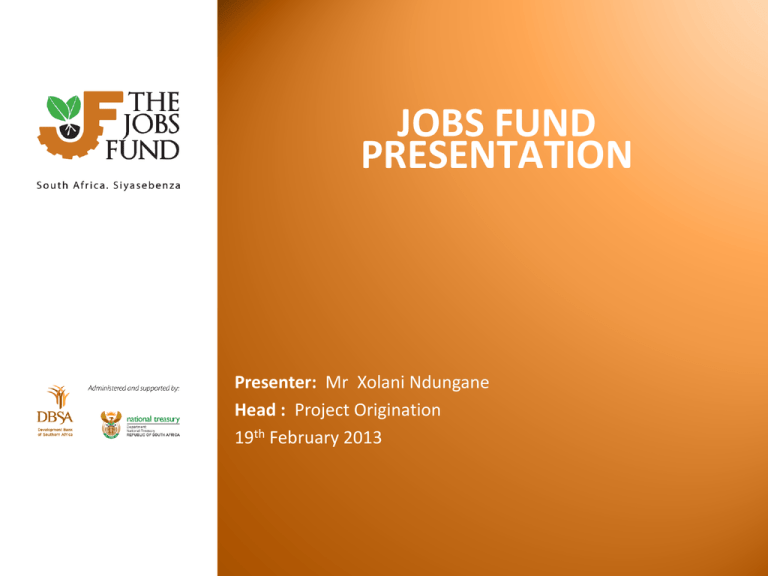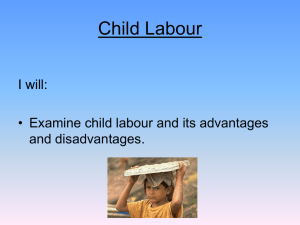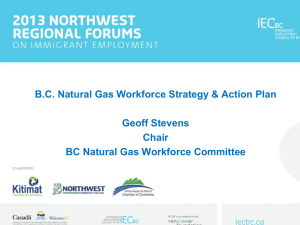A SUMMURY OF THE BUGDGET PROCESS.
advertisement

JOBS FUND PRESENTATION Presenter: Mr Xolani Ndungane Head : Project Origination 19th February 2013 PRESENTATION OUTLINE • • • • • • • • • • Background of the Jobs Fund What the Jobs Fund tries to achieve Jobs Fund focus areas How the Jobs Fund windows help to overcome labour market failures The goals of the Jobs Fund How the Jobs Fund differs from other initiatives Strategic principles applied by the Jobs Fund What the Jobs Fund will not fund Targeted beneficiaries Initial project assessment criteria 2 BACKGROUND OF THE JOBS FUND The Fund was announced by the President during the State of the Nation Address in Feb 2011 The Jobs Fund is aimed at piloting and up scaling existing innovative approaches to employment creation The Fund’s activities include planning, financing and oversight of implementation of job creation projects The Minister of Finance appointed DBSA as an implementing agent The National Treasury has allocated R 9billion towards the Fund & expects the Fund to leverage approximately R10 billion from the private and public sector. 3 WHAT THE JOBS FUND TRIES TO ACHIEVE •To address the challenge of unemployment in a sustainable manner •The Jobs Fund is not intended to tackle the long-term, structural causes of low growth and unemployment. •Other government policy initiatives are directed at these challenges & JF does not aim to replicate or substitute these initiatives. •The Jobs Fund presents an opportunity, rather, to complement these efforts with a limited and targeted programme of support for effective labour market interventions and promising job creation projects. •This does not, however, lessen the need to deal with structural problems. 4 WHAT THE JOBS FUND TRIES TO ACHIEVE Without limiting the scope of possible projects to be supported, the Jobs Fund will be used to explore approaches for overcoming five barriers that have been identified. •Opportunities for partnership between the private, public and NGO sectors frequently face institutional hurdles that can be overcome through new incentives or better collaboration mechanisms. •Enterprises face risk and cost barriers when testing new models and projects. •The kinds of low-cost infrastructure that provide shelter and security for local trading opportunities and improve market access of informal and small enterprises are frequently missing or inadequately maintained. •There is a general mismatch between the skills set of unemployed work seekers and available opportunities for employment. •Many public institutions that could help to facilitate job creation have weak expertise and poorly designed programmes. THE JOBS FUND AIMS TO EXPLORE OPTIONS FOR TACKLING THESE FIVE BARRIERS BY PROVIDING FUNDING THROUGH FOUR FUNDING “WINDOWS”. 5 JOBS FUND FOCUS AREAS Window 1 – Enterprise Development: •This window co-finances innovative business development projects, or enterprise support programmes, with potential to create sustainable jobs. •The role of the window is to lower the cost and risk barriers that inhibit innovative, private sector-led models, partnerships, ideas and projects that will directly enhance sustainable job creation. Window 2 – Infrastructure: •The infrastructure window involves the co-financing of critical missing infrastructure which either –creates trading opportunities and enhances access to markets, or –enhances the quality and security of work in established trading centres and light business environment for small enterprises, or –make the difference between employment-linked investment taking place or not. •The window also lower the cost and risk barriers (relating to infrastructure) that inhibit innovative, enterprise models, partnerships, ideas and projects that will directly enhance sustainable job creation. The goal of Windows 1 and 2 is to increase the demand for labour. 6 JOBS FUND FOCUS AREAS Window 3 – Support for work seekers: •This window provides co-financing support to innovative initiatives and programmes that directly link active work-seekers, especially young people, to formal sector opportunities and employment placements. Window 3’s goal is to improve the supply of labour. Window 4 – Institutional capacity building: •Funding from the institutional window aims to improve the capacity and efficiency of public institutions responsible for facilitating job placement, job creation and the functioning of the labour market. Window 4’s goal is to improve the operation of the labour market. 7 HOW THE JOBS FUND WINDOWS HELP TO OVERCOME LABOUR MARKET FAILURES Window 1 Enterprise Development Window 2 Infrastructure Increase demand for labour Improves quality of supply of labour Improves functionality of labour market Window 4 Institutional capacity building 8 Window 3 Support for work seekers THE GOALS OF THE JOBS FUND •The ultimate goal of the Jobs Fund is to identify and learn from effective interventions and programmes that will contribute to accelerated job creation and a better functioning labour market. •The specific goal of the Jobs Fund is to provide a mechanism that can identify and fund creative solutions to overcome identified barriers to job creation and active labour markets. •In the process, the Jobs Fund aims to create a minimum of 150 000 sustainable jobs in South Africa over a five-year period. A “sustainable” job in the context means a new, full-time equivalent job that is self-sustaining beyond the lifetime of the initial grant. 9 THE GOALS OF THE JOBS FUND The Jobs Fund will be judged a success by four outcomes: • The establishment of a portfolio of sustainable employment initiatives across all the funding windows, which together yield 150,000 sustainable jobs in three years. • The uncovering, development and operation of innovative models, partnerships and initiatives in a number of sectors from which valuable lessons are derived which inform longer term approaches to employment creation. • The transformative improvement of the prospects of unemployed people involved in Jobs Fund initiatives. • The effective implementation of the Fund within the time-scale and budget defined for it. 10 HOW THE JOBS FUND DIFFERS FROM OTHER INITIATIVES A Challenge Fund: •The Jobs Fund has been designed as a Challenge Fund. The effectiveness of Challenge Funds lies in two features: –Open competition: Challenge funding is allocated to projects on open, competitive basis. Public requests for proposals are issued to the private, public and NGO sectors. The Fund is open to applications across all sectors and from all geographic regions. The open architecture ensures that, as long as the overarching objective of creating sustainable employment is met, all good ideas are eligible to compete for funding, and the best ideas rise to the top. This ensures a pipeline of applicants and projects far richer than conventional funding intermediaries can typically achieve. Open competition directly spurs innovation, drawing on the ‘wisdom of many’ as opposed to the handful of mandated institutions that follow conventional approaches to development funding. –The once-off, limited duration of the grant along with the requirement for matched funding by the applicant. The applicant must put forward a matched funding contribution. This limits the scope for distortionary subsidies which can inhibit economic activity; undermine incentives and which can lead to dependency on the state. It also ensures the applicant has some “skin in the game: - put simply, a good incentive to ensure the project is successful. 11 HOW THE JOBS FUND DIFFERS FROM OTHER INITIATIVES Emphasis on innovation: •The Jobs Fund is intended to provide pilot-funding for innovative approaches that unearth new job creation ideas that can be replicated at scale. •The emphasis on innovation necessarily encourages the funding of projects associated with higher risk. This would ordinarily make them less attractive to traditional funders. •Mitigating this risk with well-placed and strategic public funding allows innovation to be tested (and then replicated). Partnership approach: •The Jobs Fund recognizes the inherent role of the private sector as the largest holder and creator of employment. •The project is effectively a partnership between the financial resources of the state and existing private and public sector business expertise. 12 HOW THE JOBS FUND DIFFERS FROM OTHER INITIATIVES Rigorous evaluation of success and dissemination of learning: •The number and nature of the jobs created by the Fund will be professionally monitored and measured. •The idea is to take the guesswork out of state employment funding by testing what works, knowing what works, and disseminating the learning quickly. •Lessons from successful and unsuccessful projects will be fed into future application rounds to guide pipeline development and the decisions of the Jobs Fund Investment Committee. •Success stories will be disseminated widely to allow good models to be copied. 13 STRATEGIC PRINCIPLES APPLIED BY THE JOBS FUND PARTNERSHIP WITH INTERMEDIARIES •The Jobs Fund is a pool of capital designed for large-scale impact, not an institution with administrative capacity to deal with a large number of small projects. •The initiatives pursued by the Fund should therefore target large, “game-changing” initiatives which themselves have the capacity work with larger numbers of small-scale enterprises or initiatives. •This implies an approach geared towards finding and funding a limited number of big, partnership-based projects, rather than a proliferation of small, atomistic initiatives. PLACE A STRONG EMPHASIS ON INNOVATION AND SYSTEMIC IMPACT •The Jobs Fund seeks to prioritize projects that demonstrate job creation potential combined with “doing something differently”. •This might include new business or training models, production techniques, developing new products, or establishing new markets. •Innovation and systematic change must actively be pursued. This means that most funded initiatives should, either directly or through a catalytic effect, be explicitly oriented towards addressing the underlying causes of unemployment and its persistence, and not merely to pursue individual projects. 14 STRATEGIC PRINCIPLES APPLIED BY THE JOBS FUND FOCUS ON HIGH-POTENTIAL SECTORS •The Jobs Fund is explicitly open to interesting employment initiatives from all sectors and geographies across South Africa. •Moreover, the scale of the fund, at R9 billion, implies that it should necessarily have a broader lens, catalising ideas from across the economic spectrum. •However, recent experience from the implementation of similar instruments across Africa indicates that stimulating innovation, impact and learning requires a degree of focus on high potential sectors. •Thus, the challenge is to balance openness with priority sectors, players and partnerships which offer the most potential impact. •While the Fund is open to applications from all sectors, it proactively targets high labourintensive sectors, especially those absorbing unskilled and semi-skilled labour, youths and women. •Some of the sectors which conform to these characteristics are agriculture and agro-processing, tourism, construction, and retails services. •The Fund is however, forward looking and is happy to explore emerging industries with a global competitive advantage. 15 WHAT THE JOBS FUND WILL NOT FUND Bail out of distressed companies, Start-up companies and initiatives with no track record or proven capacity to implement, Training activities that are not linked to job placement, Initiatives with huge capital investment but minimal job creation potential, Loans or Advances of cash, Double Dipping Funding government coffers (projects 16 wholly funded through INITIAL PROJECT ASSESMENT CRITERIA Eligibility Impact Due diligence (e.g. Tax Clearance Certificate) Track record Private sector led/linkages Commercial basis No outstanding legal decisions Matched funding Potential for job creation Innovation Additionality Sustainability Capacity to implement Contribution to economic development Value for money Systemic change 17 CLIENT SPLIT OF APPROVALS: 1ST & 2ND CFP JF Projects Approved Grant Amount (R'm) Matched Funding (R'm) Co-funding ratio Projected No of Permanent Jobs PUBLIC (17) 1,394.2 968.7 1:0.69 10,443 25,960 38,298 64,910 NGO/NPO (32) 812.4 730.4 1:0.90 66,330 24,575 8,937 16,971 PRIVATE (16) 1,219.2 1,423.2 1:1.17 20,480 13,395 35,992 78,006 Total Grant Approvals (65) 3,425.8 3,122.3 1:0.91 97,253 63,930 21,254 40,625 Projected No of Placements JF Avg Project Avg Cost Cost per per Job/Placement Job/Placement ‘R’ ‘R’ R1,219.2m or 35.6% R1,394.2m or 40.7% PUBLIC (17) NGO/NPO (32) PRIVATE (16) R812.4m or 23.7% • Some NGOs are part co-funded by government departments and agencies 10 PARTNERSHIP SPLIT OF APPROVALS: 1ST & 2ND CFP % of TT Grant Approved Matched Funding (R'm) Cofunding ratio Projected No of Permanent Jobs JF Avg Project Avg Cost per Cost per Projected No of Job/Placement Job/Placement ‘R’ ‘R’ Placements No. of Projects JF Projects Approved Grant Amount (R'm) 3 PUBLIC-PUBLIC 35.9 1.0% 8.2 1:0.23 1,225 300 23,569 28,970 14 PUBLIC-PRIVATE 1,705.3 49.8% 1,555.6 1:0.91 11,468 15,724 62,712 119,920 6 NGO-PUBLIC 224.9 6.6% 50.9 1:0.23 3,444 12,036 14,529 17,814 1 NGO-NGO 40.0 1.2% 40.0 1:1.00 575 69,565 139,130 25 NGO-PRIVATE 631.5 18.4% 654.9 1:1.04 62,381 21,346 7,542 15,363 752.8 22.0% 787.1 1:1.05 17,510 13,119 24,579 50,279 35.3 1.0% 25.6 1:0.73 650 1,405 17,198 29,679 3,425.8 100.0% 63,930 21,254 40,625 11 5 65 PRIVATEPRIVATE NO PARTNERSHIP TOTAL 3,122.3 1:0.91 97,253 Partnership Distribution 5 3 PUBLIC-PUBLIC (3) PUBLIC-PRIVATE (14) 14 11 NGO-PUBLIC (6) NGO-NGO (1) 6 NGO-PRIVATE (25) PRIVATE-PRIVATE (11) 25 1 11 NO PARTNERSHIPS (5) 5. FUNDING WINDOW SPLIT OF APPROVALS (R’M) & MATCHED FUNDING: 1ST & 2ND CFPS • Total grant approval of R3,425.8m matched by R3,122.3m applicant funding translates into a matched funding 2,389 2,500 2,245 2,000 JF Funding 1,110 1,279 1,000 956 779 997 1,500 1,735 1,248 Window No. of Projects Avg Grant amount ‘Rand’ ED 27 46,231,684 INFRA 7 111,311,510 SWS 26 49,191,615 ICB 5 23,872,000 TOTAL 65 52,704,277 Matched Funding Total Project Cost 60 500 119 Millions ratio of 1:0.91 0 ED INFRA SWS ICB 4 179 11. CLIENT SPLIT OF APPROVALS: 1ST & 2ND CFP JF Projects Approved Grant Amount (R'm) Matched Funding (R'm) Co-funding ratio Projected No of Permanent Jobs PUBLIC (17) 1,394.2 968.7 1:0.69 10,443 25,960 38,298 64,910 NGO/NPO (32) 812.4 730.4 1:0.90 66,330 24,575 8,937 16,971 PRIVATE (16) 1,219.2 1,423.2 1:1.17 20,480 13,395 35,992 78,006 Total Grant Approvals (65) 3,425.8 3,122.3 1:0.91 97,253 63,930 21,254 40,625 Projected No of Placements JF Avg Project Avg Cost Cost per per Job/Placement Job/Placement ‘R’ ‘R’ R1,219.2m or 35.6% R1,394.2m or 40.7% PUBLIC (17) NGO/NPO (32) PRIVATE (16) R812.4m or 23.7% • Some NGOs are part co-funded by government departments and agencies 10 13. PROVINCIAL SPLIT OF APPROVALS: 1st & 2nd CFP Approved Projects by Region and Funding Window Infra Total JF Grant (R’m) Matched Funding (R’m) Co funding Ratio Projected New Permanent Jobs 1 - 1,486.3 1,574.1 1:1.06 46,460 31,441 19,079 39,285 5 2 2 424.8 312.0 1:0.73 29,073 3,439 13,067 22,664 4 3 - 2 374.7 272.8 1:0.73 4,466 3,764 45,533 78,680 Gauteng 4 2 - 2 670.2 719.5 1:1.07 10,200 182 64,551 133,857 8 KwaZulu Natal 4 2 2 - 147.6 46.6 1:0.32 3,064 325 43,550 57,307 1 Limpopo 1 - - - 6.8 1.7 1:0.25 2,100 - 3,227 4,034 1 Mpumalanga 1 - - - 14.6 3.5 1:0.24 424 - 34,339 42,700 1 Northern Cape 1 - - - 18.3 24.8 1:1.36 320 - 57,031 134,563 1 North West - 1 - - 40.0 42.8 1:1.07 - 10,512 3,806 7,873 7 Western Cape 1 5 - 1 242.6 124.5 1:0.51 1,146 14,267 15,739 23,816 65 Totals 27 26 5 7 3,425.8 3,122.3 1:0.91 97,253 63,930 21,254 40,625 No. of Projects Region ED SWS ICB 15 National** 6 8 14 Multiple* 5 9 Eastern Cape 8 **Projects that operate in all nine provinces of South Africa. *Projects that operate in more than one, but not all nine provinces. 12 JF Avg Cost Project Avg Projected per Cost per New Job/Placement Job/Placement Placements ‘R ‘R 313 31 23 17 Services/EcoTourism 40 Services/Hospitality 410 Services/Health 400 Services/Finance 800 Services Green economy 100 Services/Mining 320 Services/Automotive Services/Real Estate Manufacturing Services/ICT 600 Agri & Forestry SECTOR SPLIT OF APPROVALS: 1ST & 2ND CFP Sector (R'm) 900 796 700 537 500 381 327 300 200 207 46 0 SECTOR SPLIT OF APPROVALS: 1st & 2nd CFP (CONT’D) No Sector Grant Amount (R'm) % of TT Grant Approved Matched Funding (R'm) Cofunding ratio Projected No of JF Avg Cost per Permanent Project Avg Cost Jobs/Placemen Job/Placemen per Job/Placement t (R) ts (R) 18 Agri & Forestry 536.9 9.9% 308.2 0.57 42,996 12,488 19,655 3 Services/ICT 320.0 10.2% 320.0 1.00 9,226 34,685 69,369 4 Manufacturing 207.2 9.2% 287.0 1.39 3,171 65,330 155,850 2 Services/Real Estate 409.9 17.9% 560.3 1.37 2,015 203,414 481,489 4 Services/Automotive 313.4 10.1% 314.6 1.00 6,014 52,119 104,424 1 Services/Mining 40.0 1.4% 42.8 1.07 10,512 3,806 7,873 2 Green economy 31.4 0.4% 11.6 0.37 528 59,470 81,439 20 Services 796.5 18.8% 586.6 0.74 55,300 14,403 25,011 4 Services/Finance 380.8 10.0% 312.6 0.82 28,979 13,141 23,928 2 Services/Health 16.7 0.4% 11.7 0.70 290 57,426 97,645 1 Services/Hospitality 46.1 9.0% 282.0 6.12 1,150 40,082 285,338 4 Services/EcoTourism 326.9 2.7% 85.0 0.26 1,002 326,270 411,054 100.0% 3,122.3 0.91 161,183 21,254 40,625 • 65 Bulk of projects sector Total in the services 3,425.8 13 Thank You 086 100 32 72 Info@jobsfund.org.za Web: www.jobsfund.org.za 25






